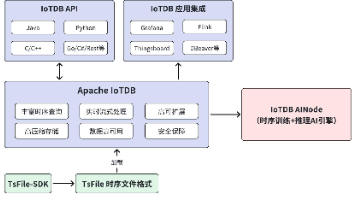【你好Ribbon】六:Ribbon负载均衡服务器指标管理器 (一)netflix-statistics
每日一句不要因为怕被玫瑰的刺伤到你,就不敢去摘玫瑰。目录前言netflix-statistics继承关系DataCollectorDistributionDataBufferHistogramDataAccumulatorDataDistributionDataPublisher前言上一节我们知道了Ribbon是通过ServerList来管理获取服务器列表的方式。虽然现在没有说到Ribbon负载均
每日一句
不要因为怕被玫瑰的刺伤到你,就不敢去摘玫瑰。
目录
前言
上一节我们知道了Ribbon是通过ServerList来管理获取服务器列表的方式。虽然现在没有说到Ribbon负载均衡器是如何工作的,但是大致应该是 获取服务列表 过滤服务列表 根据负载策略选择具体的服务器。那么如果我需要根据服务器的负载量来选择服务,或者根据请求服务器的失败率来过滤服务器。 这些服务器的指标数据 Ribbon是存储在哪里的,又是如何统计的。今天我们就来看一下和服务器指标有关的两个类ServerStats&LoadBalancerStats
netflix-statistics
在聊ServerStats之前我们先来看看Ribbon是如何对数据进行收集的。这就需要了解netflix-commons工程下面的netflix-statistics模块,该模块用来对指标数据收集。很简单 简略的介绍一下。
继承关系

可以看到这个模块就6个核心类,一共10个类。
- DataCollector 数据收集父接口 只提供noteValue方法
- Distribution以增量的方式生成 实现是线程不安全的
- DataBufferd固定大小的数据收集缓存区 一个最近添加值得一个滑动窗口
- Histogram跟踪每一个存储桶的计数 来查找中位数
- DataAccumulator数据累加器 维护了双缓存区
- DataDistribution数据发布 具有实际的发布能力
DataCollector
数据收集 该接口非常简单 只有一个方法
public interface DataCollector {
//记录一个数据值
void noteValue(double val);
}
Distribution
统计量累加器 以增量的方式产生值。实现是线程不安全的,同时更新会产生错误的结果。在大多数情况下,这些不正确的结果往往是不重要的。
//数量累加
private lo ng numValues;
//值累加
private double sumValues;
//平方累加
private double sumSquareValues;
//最小值
private double minValue;
//最大值
private double maxValue;
public Distribution() {
numValues = 0L;
sumValues = 0.0;
sumSquareValues = 0.0;
minValue = 0.0;
maxValue = 0.0;
}
/** 记录值 */
public void noteValue(double val) {
numValues++;
sumValues += val;
sumSquareValues += val * val;
if (numValues == 1) {
minValue = val;
maxValue = val;
} else if (val < minValue) {
minValue = val;
} else if (val > maxValue) {
maxValue = val;
}
}
/** 恢复默认配置 */
public void clear() {
numValues = 0L;
sumValues = 0.0;
sumSquareValues = 0.0;
minValue = 0.0;
maxValue = 0.0;
}
该类非常简单就是对要记录的值得一个简单操作 统计。最大值,最小值,平方值,统计总数,总值不难发现这些值都是最终的值 没法记录过程。某段时间内的指标是无法做到的。
DataBuffer
光看名字就知道 它提供了数据缓存能力 具有记录过程中值得能力。
//锁 可以外部可以通过getLock来管理对 buf内容的访问
private final Lock lock;
//数据缓存区
private final double[] buf;
//开始统计的时间
private long startMillis;
//结束统计的时间
private long endMillis;
//缓存区大小
private int size;
//当前插入的位置
private int insertPos;
@Override
public void noteValue(double val) {
//对值得最终统计
super.noteValue(val);
//如果值过多就会对之前的内容造成覆盖 所以这是一个滑动的统计
buf[insertPos++] = val;
if (insertPos >= buf.length) {
insertPos = 0;
size = buf.length;
} else if (insertPos > size) {
size = insertPos;
}
}
//开始收集
public void startCollection() {
clear();
startMillis = System.currentTimeMillis();
}
//结束收集
public void endCollection() {
endMillis = System.currentTimeMillis();
Arrays.sort(buf, 0, size);
}
上面的方法很简单。下面我们来搞清楚一个概念:分位数 这个是统计学中的术语。
- 二分位数: 对于有限的数集,可以通过把所有观察值高低排序后找出正中间的一个作为中位数。如果观察值有偶数个,则中位数不唯一,通常取最中间的两个数值的平均数作为中位数,即二分位数。
- **四分位数:**是统计学中分位数的一种,即把所有数值由小到大排列并分成四等份,处于三个分割点位置的数值就是四分位数。
- *百分位数:如果将一组数据从小到大排序,并计算相应的累计百分位,则某一百分位所对应数据的值就称为这一百分位的百分位数。可表示为:一组n个观测值按数值大小排列。如,处于p%位置的值称第p百分位数。(***百分位通常用第几百分位来表示,如第五百分位,它表示在所有测量数据中,测量值的累计频次达5%。以身高为例,身高分布的第五百分位表示有5%的人的身高小于此测量值,95%的身高大于此测量值。)
下面看DataBuffer为我们提供计算百分位数的方法:
public double[] getPercentiles(double[] percents, double[] percentiles) {
for (int i = 0; i < percents.length; i++) {
percentiles[i] = computePercentile(percents[i]);
}
return percentiles;
}
private double computePercentile(double percent) {
// Some just-in-case edge cases
if (size <= 0) {
return 0.0;
} else if (percent <= 0.0) {
return buf[0];
} else if (percent >= 100.0) {
return buf[size - 1];
}
double index = (percent / 100.0) * size;
int iLow = (int) Math.floor(index);
int iHigh = (int) Math.ceil(index);
assert 0 <= iLow && iLow <= index && index <= iHigh && iHigh <= size;
assert (iHigh - iLow) <= 1;
if (iHigh >= size) {
// Another edge case
return buf[size - 1];
} else if (iLow == iHigh) {
return buf[iLow];
} else {
return buf[iLow] + (index - iLow) * (buf[iHigh] - buf[iLow]);
}
}
***上面的方法 解释一下 例如 缓存 50个值 我们传的是percent 是10 也就是要计算第10百分位的值 也就是要求x 这个x需要满足 10%的值小于x 90%的值大于x *** 明白了吗,没明白 我们再来个例子。
DataBuffer dataBuffer = new DataBuffer(20);
//开始收集
dataBuffer.startCollection();
for (int i = 0; i < 20; i++) {
dataBuffer.noteValue(i);
}
//结束收集
dataBuffer.endCollection();
//我们这里需要计算10分位数 50分位数 90分位数的值
//根据我们的预测 10分位数应该是 2 50分位数对应的是10 90分位数对应的是 18
double[] percents = new double[]{10,50,90};
double[] percentiles = new double[percents.length];
dataBuffer.getPercentiles(percents , percentiles);
for (int i = 0; i < percentiles.length; i++) {
System.out.println(percentiles[i]);
}
上面的例子模拟了一个计算百分位数的过程。实际输出 和我们预测的结果是一毛一样的。好了 它就是这么简单。
Histogram
这个我们就跳过 Ribbon没有直接使用到。
DataAccumulator
数据统计 ,拥有双缓冲区,一个是当前缓存区 用来向其中添加新数据。另一个是上一个缓存区,用于计算统计信息。
//当前缓存区 用来添加新数据 这个DataBuffer正是我们上面说到的
private DataBuffer current;
// 上一个缓存区
private DataBuffer previous;
private final Object swapLock = new Object();
//记录一个值 这里加了swapLock 交换锁 大家应该能猜到 在执行数据交换的时候是无法新增的。
//所谓的数据交换就是 将current缓存的值 复制到previous中的过程。
public void noteValue(double val) {
synchronized (swapLock) {
Lock l = current.getLock();
l.lock();
try {
//记录当前值
current.noteValue(val);
} finally {
l.unlock();
}
}
}
//数据交换 并且计算上一个缓存区
public void publish() {
DataBuffer tmp = null;
Lock l = null;
//下面是一个交换值的过程 上面说了交换的时候不能新增 所以这里加了swapLock
synchronized (swapLock) {
// Swap buffers
tmp = current;
current = previous;
previous = tmp;
l = current.getLock();
l.lock();
try {
//当前缓存清空
current.startCollection();
} finally {
l.unlock();
}
l = tmp.getLock();
l.lock();
}
try {
//结束收集
tmp.endCollection();
publish(tmp);
} finally {
l.unlock();
}
}
//具体的发布(计算)交给子类实现
protected abstract void publish(DataBuffer buf);
上面代码主要是一个收集和交换的过程。收集和交换这两个操作是互斥的。
交换过程:
- 使用临时变量temp进行交换操作
- 交换完成当前缓存区调用startCollection清空缓存区 准备再次开始收集。
- 临时缓存区调用endCollection结束收集,并把临时缓存区传入publish方法交由子类处理
DataDistribution
DataDistribution是DataAccumulator的唯一实现。那它最重要的就是实现了父类留下来的publish方法 来计算当前缓存区留下来的值。
//统计数据总个数
private long numValues = 0L;
//统计数据平均数
private double mean = 0.0;
//方差
private double variance = 0.0;
//标准差
private double stddev = 0.0;
//最小值
private double min = 0.0;
//最大值
private double max = 0.0;
//数据发布时间
private long ts = 0L;
//样本时间
private long interval = 0L;
private int size = 0;
//下面两个值 我们上面介绍过 百分位数 和百分位数对应的值
private final double[] percents;
private final double[] percentiles;
public DataDistribution(int bufferSize, double[] percents) {
super(bufferSize);
assert percentsOK(percents);
this.percents = percents;
this.percentiles = new double[percents.length];
}
//参数校验
private static boolean percentsOK(double[] percents) {
if (percents == null) {
return false;
}
for (int i = 0; i < percents.length; i++) {
if (percents[i] < 0.0 || percents[i] > 100.0) {
return false;
}
}
return true;
}
//数据发布
protected void publish(DataBuffer buf) {
//记录发布时间
ts = System.currentTimeMillis();
//数据发布总数 这个总数最终是由Distribution提供
numValues = buf.getNumValues();
//下面是对上面介绍属性赋值的过程 就不一一注释了。
mean = buf.getMean();
variance = buf.getVariance();
stddev = buf.getStdDev();
min = buf.getMinimum();
max = buf.getMaximum();
interval = buf.getSampleIntervalMillis();
size = buf.getSampleSize();
//通过我们上面介绍的这个方法 来计算百分位数
buf.getPercentiles(percents, percentiles);
}
//初始化
public void clear() {
.....
}
DataPublisher
数据发布器 听名字就知道是调用DataAccumulator的publish方法进行数据定时发布。使用定时器来定时对数据发布。这里就不贴源码了,比较简单。直接上一个demo
final DataDistribution accumulator = new DataDistribution(20 ,
new double[]{10 , 50 , 90});
DataPublisher dataPublisher = new DataPublisher(accumulator , 2000);
dataPublisher.start();
new Thread(new Runnable() {
@Override
public void run() {
for (int i = 1; i < 1000; i++) {
try {
accumulator.noteValue(i);
Thread.sleep(100);
} catch (InterruptedException e) {
e.printStackTrace();
}
}
}
}).start();
ScheduledExecutorService executorService = Executors.newScheduledThreadPool(1);
executorService.scheduleWithFixedDelay(new Runnable() {
@Override
public void run() {
System.out.println("=======时间:" + accumulator.getTimestamp() + "=======");
System.out.println("总个数:" + accumulator.getNumValues());
System.out.println("统计周期:" + accumulator.getSampleIntervalMillis() );
System.out.println("样本数据个数:" + accumulator.getSampleSize());
System.out.println("最大值:" + accumulator.getMaximum());
System.out.println("最小值:" + accumulator.getMinimum());
System.out.println("平均值:" + accumulator.getMean());
System.out.println("方差:" + accumulator.getVariance());
System.out.println("标准差:" + accumulator.getStdDev());
System.out.println("分位数:" + Arrays.toString(accumulator.getPercents()));
System.out.println("分位数值:" + Arrays.toString(accumulator.getPercentiles()));
}
}, 2500, 2500, TimeUnit.MILLISECONDS);
TimeUnit.SECONDS.sleep(Integer.MAX_VALUE);
上面的例子 我们定义了一个DataDistribution来产生数据,DataPublisher绑定DataDistribution用来定时发送数据。
程序输出:
=======时间:Tue Nov 24 22:16:51 CST 2020=======
总个数:20
统计周期:1606227411869
样本数据个数:20
最大值:20.0
最小值:1.0
平均值:10.5
方差:33.25
标准差:5.766281297335398
分位数:[10.0, 50.0, 90.0]
分位数值:[3.0, 11.0, 19.0]
=======时间:Tue Nov 24 22:16:53 CST 2020=======
总个数:19
统计周期:2002
样本数据个数:19
最大值:39.0
最小值:21.0
平均值:30.0
方差:30.0
标准差:5.477225575051661
分位数:[10.0, 50.0, 90.0]
分位数值:[22.9, 30.5, 38.1]
到这里我们就把铺垫工作做好了。netflix-statistics比较简单 但是为了后面我们能很好的理解ServerStats 还是有必要把基础的类讲解一下的。

更多推荐
 已为社区贡献1条内容
已为社区贡献1条内容









所有评论(0)